Application of Two-Element Zn-Al Metallic Target for Deposition of Aluminum-Doped Zinc Oxide—Analysis of Sputtering Process and Properties of Obtained Transparent Conducting Films
Abstract
1. Introduction
2. Materials and Methods
2.1. Sputtering System
2.2. Deposition Processes
2.3. Measurements
2.4. Two-Element Zn-Al Target
2.5. Monitoring of Sputtering Conditions with DPS Power Supply
3. Results
3.1. Transmission of Light
3.2. Electrical Properties—Resistivity
3.3. Surface Properties, Elemental Composition and Microstructure
3.4. Optical Emission of Plasma (OES)
4. Discussion and Conclusions
Author Contributions
Funding
Institutional Review Board Statement
Informed Consent Statement
Data Availability Statement
Conflicts of Interest
References
- Kelly, P.J.; Arnell, R.D. Magnetron Sputtering: A Review of Recent Developments and Applications. Vacuum 2000, 56, 159–172. [Google Scholar] [CrossRef]
- McLeod, P.S.; Hartsough, L.D. High-rate Sputtering of Aluminum for Metallization of Integrated Circuits. J. Vac. Sci. Technol. 1977, 14, 263–265. [Google Scholar] [CrossRef]
- Waits, R.K. Planar Magnetron Sputtering. J. Vac. Sci. Technol. 1978, 15, 179–187. [Google Scholar] [CrossRef]
- Gao, Z.; Banerjee, P. Review Article: Atomic Layer Deposition of Doped ZnO Films. J. Vac. Sci. Technol. A Vac. Surf. Film. 2019, 37, 050802. [Google Scholar] [CrossRef]
- Minami, T. Transparent Conducting Oxide Semiconductors for Transparent Electrodes. Semicond. Sci. Technol. 2005, 20, S35–S44. [Google Scholar] [CrossRef]
- Liu, Y.; Li, Y.; Zeng, H. ZnO-Based Transparent Conductive Thin Films: Doping, Performance, and Processing. J. Nanomater. 2013, 2013, 196521. [Google Scholar] [CrossRef]
- Liu, C.C.; Chen, Y.S.; Huang, J.J. High-Performance ZnO Thin-Film Transistors Fabricated at Low Temperature on Glass Substrates. Electron. Lett. 2006, 42, 824–825. [Google Scholar] [CrossRef]
- Asenjo, B.; Chaparro, A.M.; Gutiérrez, M.T.; Herrero, J.; Klaer, J. Study of CuInS2/Buffer/ZnO Solar Cells, with Chemically Deposited ZnS-In2S3 Buffer Layers. Thin Solid Film. 2007, 515, 6036–6040. [Google Scholar] [CrossRef]
- Yang, J.; Park, J.K.; Kim, S.; Choi, W.; Lee, S.; Kim, H. Atomic-layer-deposited ZnO Thin-film Transistors with Various Gate Dielectrics. Phys. Status Solidi 2012, 209, 2087–2090. [Google Scholar] [CrossRef]
- Wang, J.-C.; Weng, W.-T.; Tsai, M.-Y.; Lee, M.-K.; Horng, S.-F.; Perng, T.-P.; Kei, C.-C.; Yu, C.-C.; Meng, H.-F. Highly Efficient Flexible Inverted Organic Solar Cells Using Atomic Layer Deposited ZnO as Electron Selective Layer. J. Mater. Chem. 2010, 20, 862–866. [Google Scholar] [CrossRef]
- Chen, H.-C.; Chen, M.-J.; Wu, M.-K.; Li, W.-C.; Tsai, H.-L.; Yang, J.-R.; Kuan, H.; Shiojiri, M. UV Electroluminescence and Structure of N-ZnO/p-GaN Heterojunction LEDs Grown by Atomic Layer Deposition. IEEE J. Quantum Electron. 2010, 46, 265–271. [Google Scholar] [CrossRef]
- Elam, J.W.; Sechrist, Z.A.; George, S.M. ZnO/Al2O3 Nanolaminates Fabricated by Atomic Layer Deposition: Growth and Surface Roughness Measurements. Thin Solid Film. 2002, 414, 43–55. [Google Scholar] [CrossRef]
- Kim, K.H.; Park, K.C.; Ma, D.Y. Structural, Electrical and Optical Properties of Aluminum Doped Zinc Oxide Films Prepared by Radio Frequency Magnetron Sputtering. J. Appl. Phys. 1997, 81, 7764–7772. [Google Scholar] [CrossRef]
- Agashe, C.; Kluth, O.; Schöpe, G.; Siekmann, H.; Hüpkes, J.; Rech, B. Optimization of the Electrical Properties of Magnetron Sputtered Aluminum-Doped Zinc Oxide Films for Opto-Electronic Applications. Thin Solid Film. 2003, 442, 167–172. [Google Scholar] [CrossRef]
- Banerjee, P.; Lee, W.-J.; Bae, K.-R.; Lee, S.B.; Rubloff, G.W. Structural, Electrical, and Optical Properties of Atomic Layer Deposition Al-Doped ZnO Films. J. Appl. Phys. 2010, 108, 043504. [Google Scholar] [CrossRef]
- Nam, T.; Lee, C.W.; Kim, H.J.; Kim, H. Growth Characteristics and Properties of Ga-Doped ZnO (GZO) Thin Films Grown by Thermal and Plasma-Enhanced Atomic Layer Deposition. Appl. Surf. Sci. 2014, 295, 260–265. [Google Scholar] [CrossRef]
- Barhoumi, A.; Leroy, G.; Duponchel, B.; Gest, J.; Yang, L.; Waldhoff, N.; Guermazi, S. Aluminum Doped ZnO Thin Films Deposited by Direct Current Sputtering: Structural and Optical Properties. Superlattices Microstruct. 2015, 82, 483–498. [Google Scholar] [CrossRef]
- Yamamoto, T.; Katayama-Yoshida, H. Physics and Control of Valence States in ZnO by Codoping Method. Phys. B Condens. Matter 2001, 302–303, 155–162. [Google Scholar] [CrossRef]
- Ellmer, K.; Bikowski, A. Intrinsic and Extrinsic Doping of ZnO and ZnO Alloys. J. Phys. D Appl. Phys. 2016, 49, 413002. [Google Scholar] [CrossRef]
- Posadowski, W.; Wiatrowski, A.; Domaradzki, J.; Mazur, M. Selected Properties of AlxZnyO Thin Films Prepared by Reactive Pulsed Magnetron Sputtering Using a Two-Element Zn/Al Target. Beilstein J. Nanotechnol. 2022, 13, 344–354. [Google Scholar] [CrossRef]
- Posadowski, W.M.; Wiatrowski, A.; Dora, J.; Radzimski, Z.J. Magnetron Sputtering Process Control by Medium-Frequency Power Supply Parameter. Thin Solid Film. 2008, 516, 4478–4482. [Google Scholar] [CrossRef]
- Kiełczawa, S. Specific Method of Deposition of Aluminium-Doped Zinc Oxide Thin Films on Flexible Glass Substrates. Electrotech. Rev. 2022, 1, 249–252. [Google Scholar] [CrossRef]
- Klug, H.P.; Alexander, L.E. X-Ray Diffraction Procedures: For Polycrystalline and Amorphous Materials; Wiley: New York, NY, USA, 1976; ISBN 978-0-471-49369-3. [Google Scholar]
- Eckstein, W. Sputtering Yields. In Sputtering by Particle Bombardment; Topics in Applied Physics; Springer: Berlin/Heidelberg, Germany, 2007; Volume 110, pp. 33–187. ISBN 978-3-540-44500-5. [Google Scholar]
- Tominaga, K.; Ueshiba, N.; Shintani, Y.; Tada, O. High-Energy Neutral Atoms in the Sputtering of ZnO. Jpn. J. Appl. Phys. 1981, 20, 519. [Google Scholar] [CrossRef]
- Depla, D.; Heirwegh, S.; Mahieu, S.; Haemers, J.; De Gryse, R. Understanding the Discharge Voltage Behavior during Reactive Sputtering of Oxides. J. Appl. Phys. 2007, 101, 013301. [Google Scholar] [CrossRef]
- Subramanyam, T.K.; Goutham, P.; Pavan Kumar, S.; Yadhuraj, S.R.; Geetha, K.S. Optimization of Sputtered AZO Thin Films for Device Application. Mater. Today Proc. 2018, 5, 10851–10859. [Google Scholar] [CrossRef]
- Bussell, B.C.; Gibson, P.N.; Lawton, J.; Couture, P.; Sharpe, M.K.; England, J.; Hinder, S.J.; Stolojan, V.; Thornley, S.A.; Baker, M.A. The Effect of RF Plasma Power on Remote Plasma Sputtered AZO Thin Films. Surf. Coat. Technol. 2022, 442, 128402. [Google Scholar] [CrossRef]
- Wiatrowski, A.; Patela, S.; Kunicki, P.; Posadowski, W. Effective Reactive Pulsed Magnetron Sputtering of Aluminium Oxide—Properties of Films Deposited Utilizing Automated Process Stabilizer. Vacuum 2016, 134, 54–62. [Google Scholar] [CrossRef]
- Qiao, Z.; Agashe, C.; Mergel, D. Dielectric Modeling of Transmittance Spectra of Thin ZnO:Al Films. Thin Solid Film. 2006, 496, 520–525. [Google Scholar] [CrossRef]
- Hsu, J.-C.; Chen, Y.-Y. Comparison of the Optical and Electrical Properties of Al-Doped ZnO Films Using a Lorentz Model. Coatings 2018, 9, 4. [Google Scholar] [CrossRef]
- Kumar, P.; Dharmaprakash, S.M. A Comparative Analysis of Structural, Optical, and Electrical Characteristics of c-Plane and a-Plane ZnO:Al Thin Films Fabricated by a Pulsed Laser Ablation Technique. Appl. Surf. Sci. 2022, 593, 153423. [Google Scholar] [CrossRef]
- Haacke, G. New Figure of Merit for Transparent Conductors. J. Appl. Phys. 1976, 47, 4086–4089. [Google Scholar] [CrossRef]
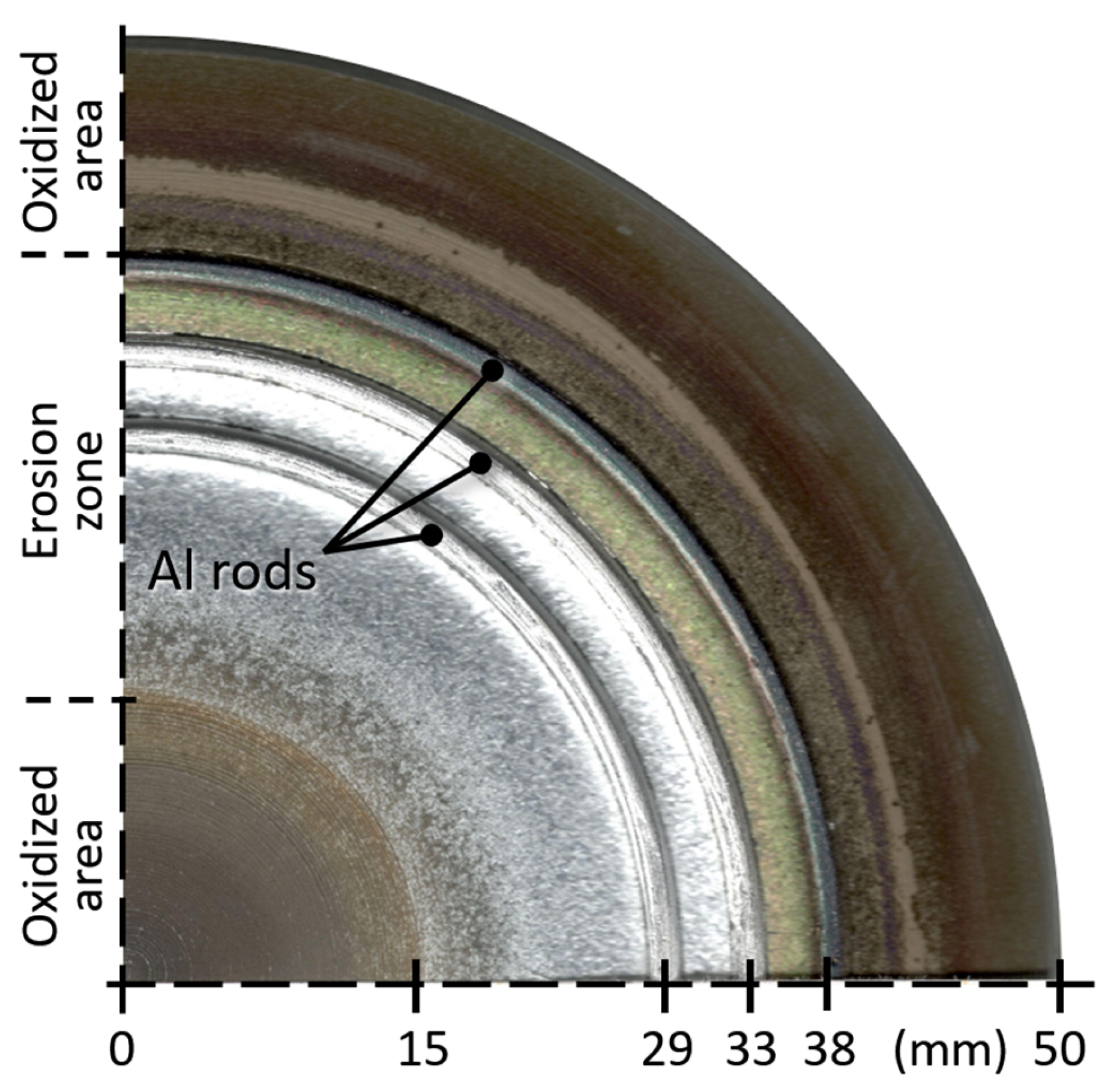
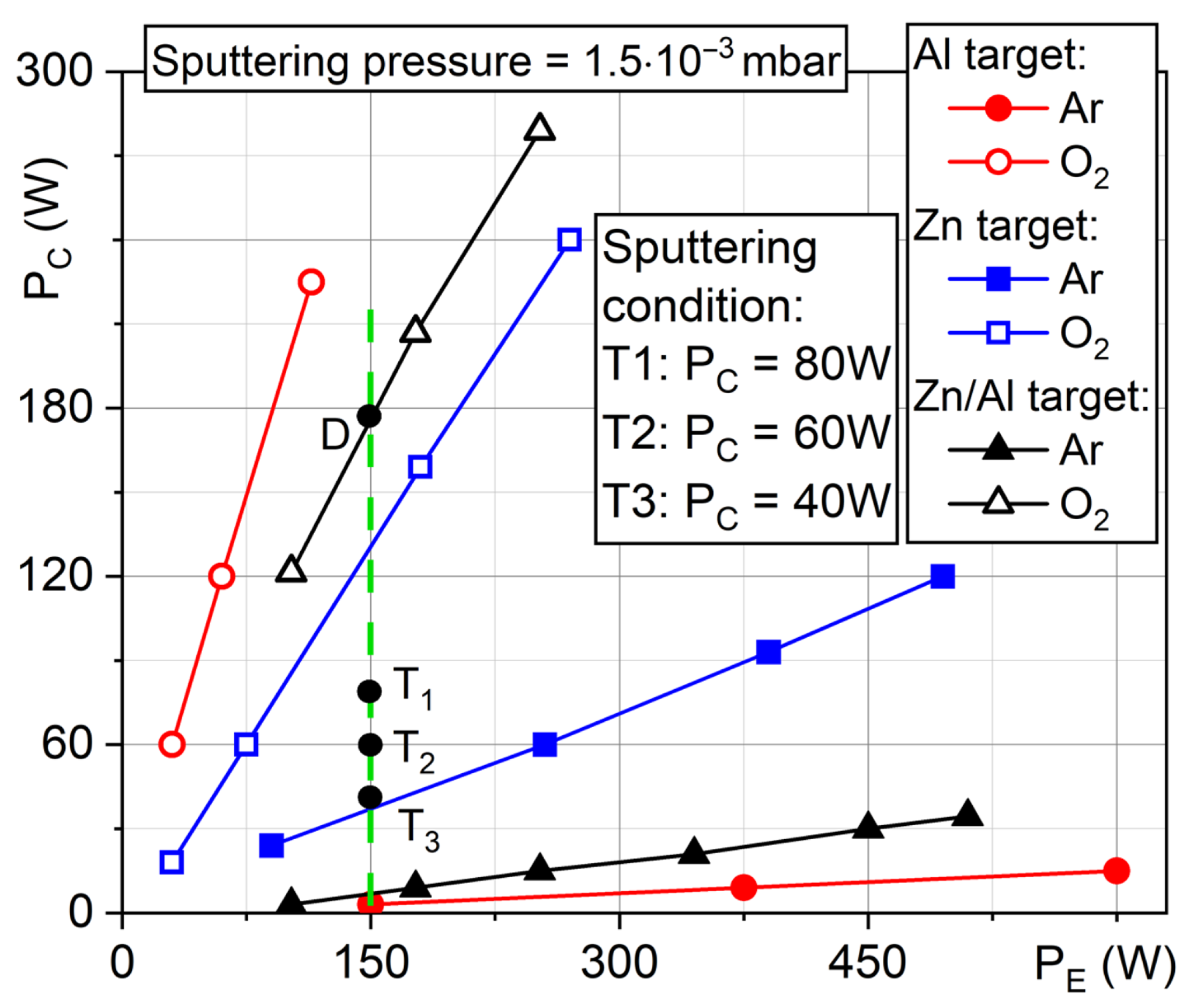


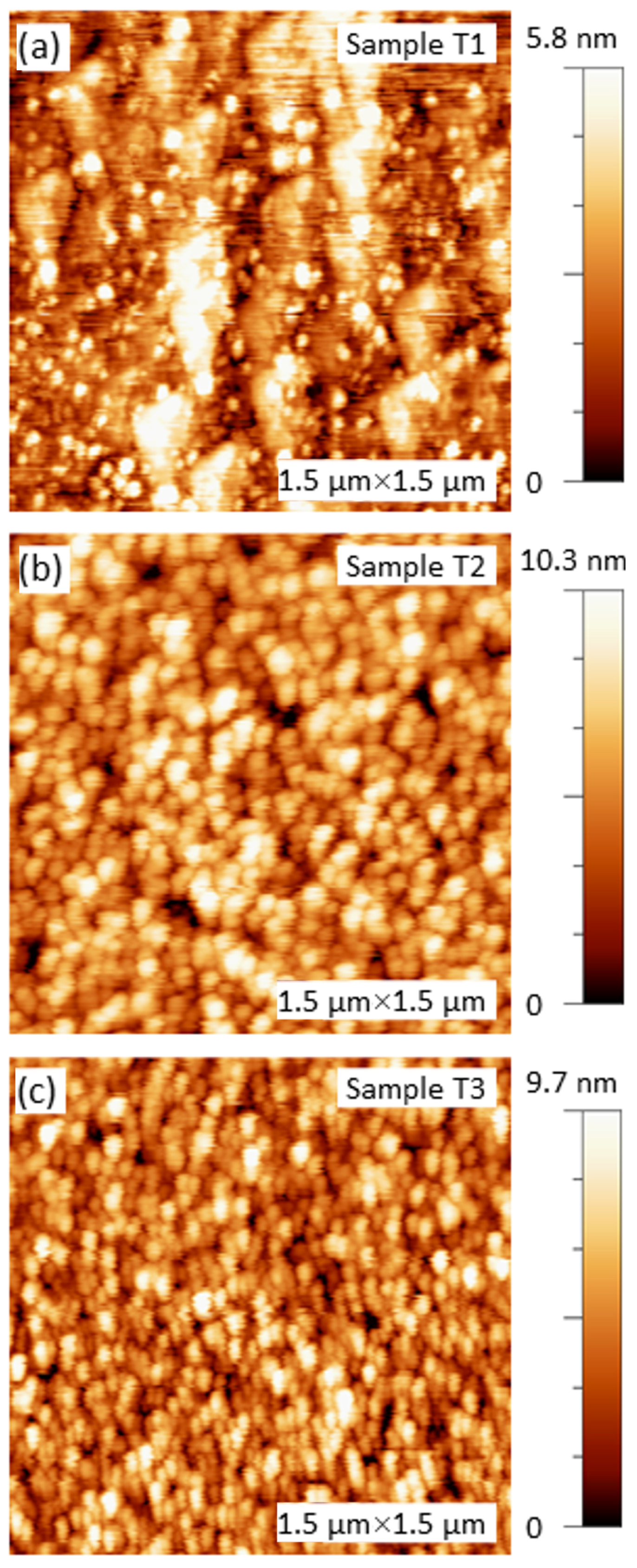

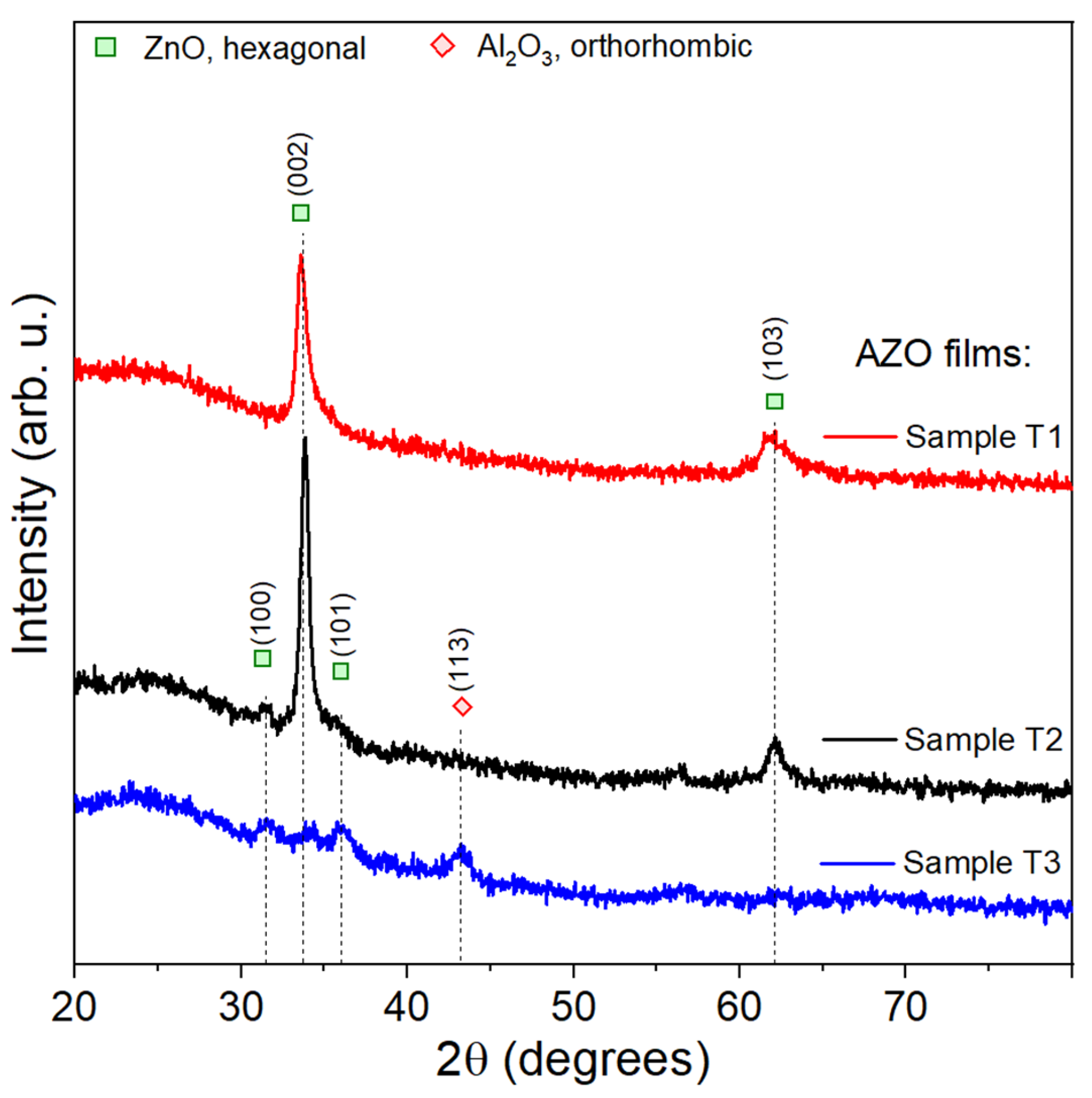
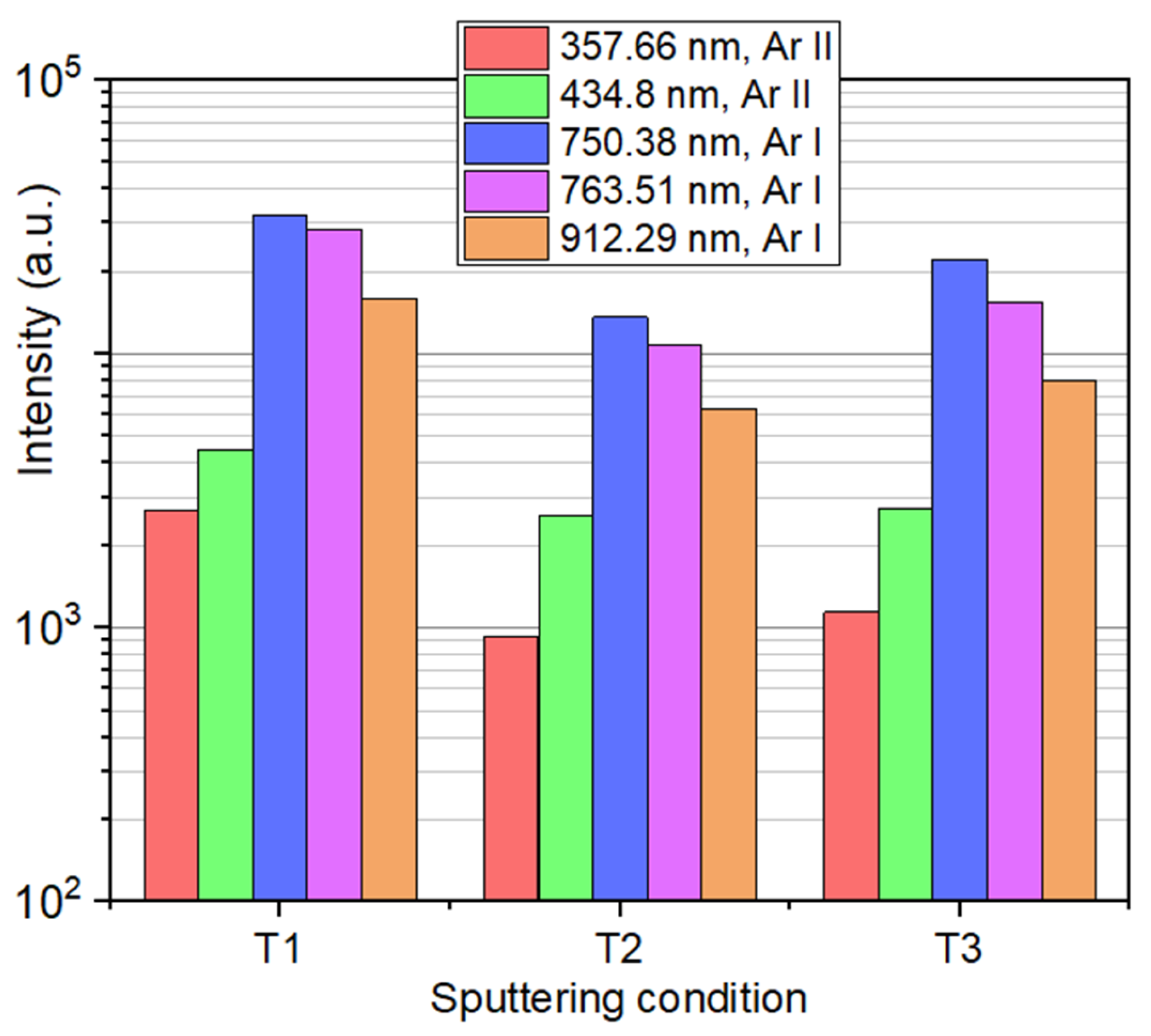
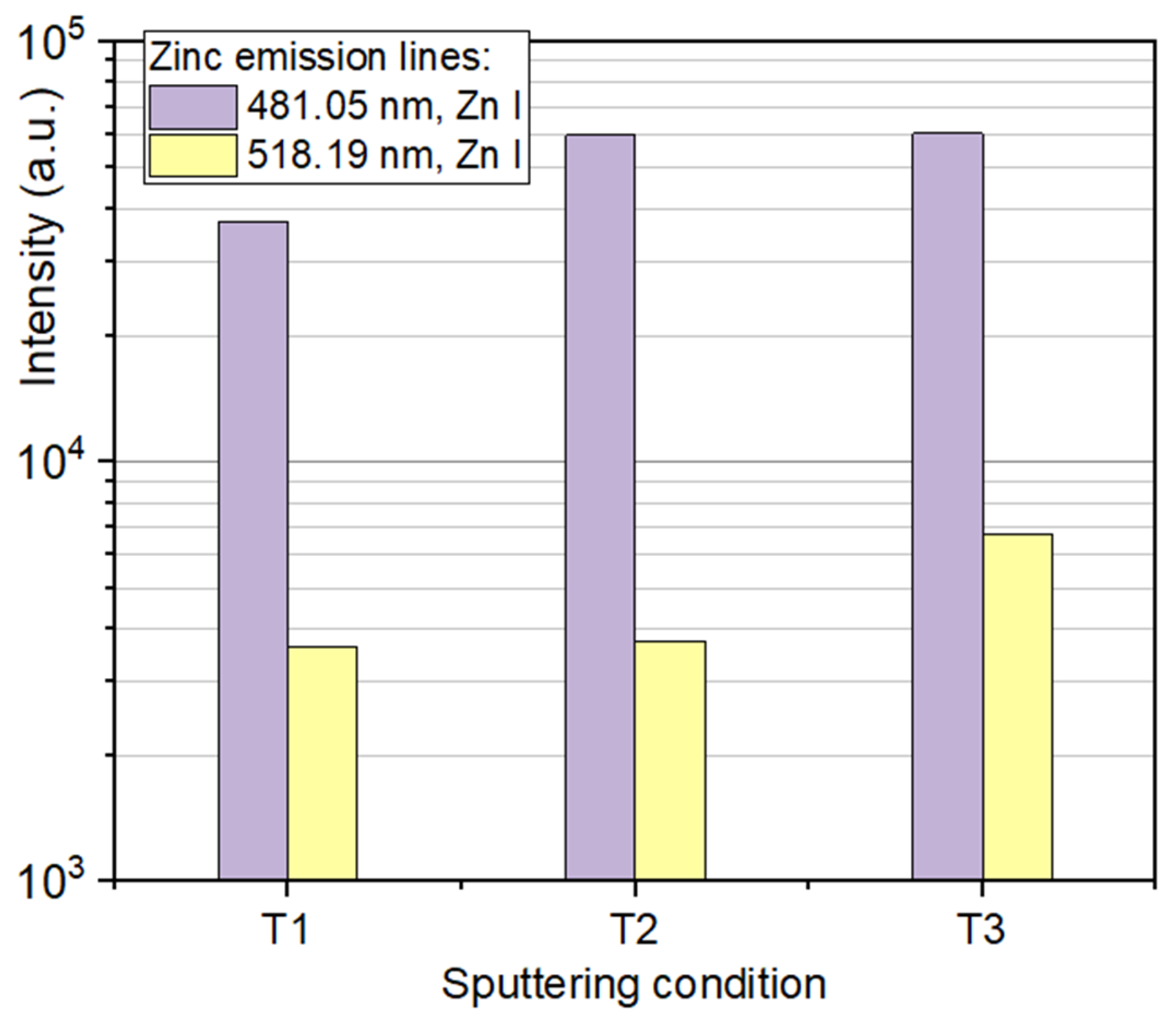
| Sample | Film Thickness (nm) | Sheet Resistance (Ω/sq.) | Resistivity 10−3 (Ω·cm) | Cut-Off Wavelength (nm) | Transmittance (Avg. Value for VIS Range) % | Figure of Merit (1/Ω·cm) | |
|---|---|---|---|---|---|---|---|
| Substrate | Ar/O2 Ratio % | ||||||
| Standard glass (Corning) | T1 (80/20) | 88 | 5391 | 47.4 | 326 | 84 | 4 |
| T2 (82/18) | 116 | 121 | 1.4 | 306 | 83 | 110 | |
| T3 (84/16) | 123 | 157 | 1.9 | 305 | 65 | 7 | |
| Flexible glass (Willow) | T1 (80/20) | 88 | 3896 | 34.3 | 300 | 86 | 6 |
| T2 (82/18) | 116 | 100 | 1.2 | 294 | 85 | 167 | |
| T3 (84/16) | 123 | 135 | 1.7 | 295 | 70 | 17 | |
| Sample | RMS Roughness (nm) | Peak-to-Peak (nm) | |
|---|---|---|---|
| Substrate | Ar/O2 Ratio % | ||
| Standard glass (Corning) | T1 (80/20) | 1.34 | 5.8 |
| T2 (82/18) | 1.86 | 10.3 | |
| T3 (84/16) | 1.81 | 9.7 | |
| Flexible glass (Willow) | T1 (80/20) | 1.21 | 5.6 |
| T2 (82/18) | 1.42 | 7.8 | |
| T3 (84/16) | 1.61 | 8.5 | |
| PC | 40 W (T3) | 60 W (T2) | 80 W (T1) | ||||
|---|---|---|---|---|---|---|---|
| Element | Atomic Number | Mass Normalized [%] | Atom [%] | Mass Normalized [%] | Atom [%] | Mass Normalized [%] | Atom [%] |
| Al | 13 | 0.6 | 0.60 | 0.5 | 0.56 | 0.5 | 0.57 |
| Zn | 30 | 13.8 | 6.22 | 17.6 | 8.03 | 15.4 | 6.94 |
| Si | 14 | 81.4 | 85.3 | 76.8 | 81.9 | 79.1 | 83.3 |
| O | 8 | 4.3 | 7.85 | 5.1 | 9.55 | 5.0 | 9.23 |
| Al/Zn ratio | 10/100 | 7/100 | 8/100 | ||||
Disclaimer/Publisher’s Note: The statements, opinions and data contained in all publications are solely those of the individual author(s) and contributor(s) and not of MDPI and/or the editor(s). MDPI and/or the editor(s) disclaim responsibility for any injury to people or property resulting from any ideas, methods, instructions or products referred to in the content. |
© 2025 by the authors. Licensee MDPI, Basel, Switzerland. This article is an open access article distributed under the terms and conditions of the Creative Commons Attribution (CC BY) license (https://creativecommons.org/licenses/by/4.0/).
Share and Cite
Kiełczawa, S.; Wiatrowski, A.; Mazur, M.; Posadowski, W.; Domaradzki, J. Application of Two-Element Zn-Al Metallic Target for Deposition of Aluminum-Doped Zinc Oxide—Analysis of Sputtering Process and Properties of Obtained Transparent Conducting Films. Coatings 2025, 15, 713. https://doi.org/10.3390/coatings15060713
Kiełczawa S, Wiatrowski A, Mazur M, Posadowski W, Domaradzki J. Application of Two-Element Zn-Al Metallic Target for Deposition of Aluminum-Doped Zinc Oxide—Analysis of Sputtering Process and Properties of Obtained Transparent Conducting Films. Coatings. 2025; 15(6):713. https://doi.org/10.3390/coatings15060713
Chicago/Turabian StyleKiełczawa, Szymon, Artur Wiatrowski, Michał Mazur, Witold Posadowski, and Jarosław Domaradzki. 2025. "Application of Two-Element Zn-Al Metallic Target for Deposition of Aluminum-Doped Zinc Oxide—Analysis of Sputtering Process and Properties of Obtained Transparent Conducting Films" Coatings 15, no. 6: 713. https://doi.org/10.3390/coatings15060713
APA StyleKiełczawa, S., Wiatrowski, A., Mazur, M., Posadowski, W., & Domaradzki, J. (2025). Application of Two-Element Zn-Al Metallic Target for Deposition of Aluminum-Doped Zinc Oxide—Analysis of Sputtering Process and Properties of Obtained Transparent Conducting Films. Coatings, 15(6), 713. https://doi.org/10.3390/coatings15060713






